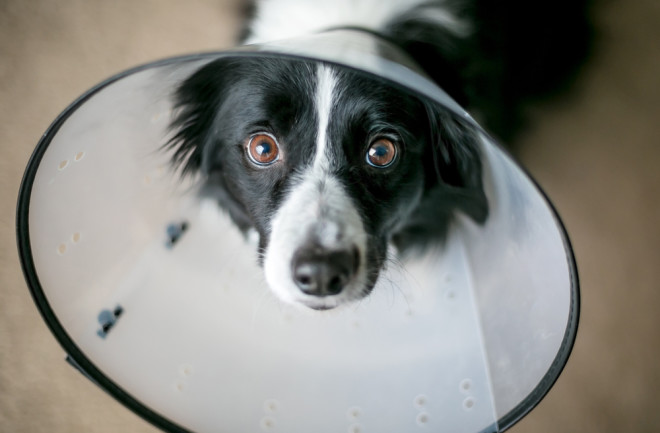The sad eyes. The whimpering. The trouble with the water dish. Sometimes, the surgical collar prescribed for a post-op pet can seem worse than the actual wound.
Researchers and clinicians call it an “Elizabethan collar” or E-collar because it resembles the fashionable fabric ruffle in Elizabethan times. Pet parents, however, know it as the “cone of shame” for how humiliated and unhappy it makes their pet.
In recent years, animal behaviorists have researched the impact of E-collars on animal welfare. Although scientists disagree on whether companion animals feel humiliation, studies find the cone of shame negatively impacts both pets and their people.
Are Animals Actually Embarrassed in the Cone of Shame?
Researchers aren’t sure if animals are embarrassed by the cone, but animal emotion studies are relatively new. For decades, scientists hesitated to study animal emotions lest they be accused of anthropomorphism. They still don’t agree on which emotions animals possess and whether we can ever truly know.
However, studies have found that secondary animal emotions like guilt or shame likely serve a purpose, even if they’re different from how we perceive them. For example, when a dog looks guilty after doing something naughty, researchers suggest it might be a way to receive a less severe scolding.
So, a pet might not feel ashamed in the cone, but they may want it off. Looking sad can convince their human to take it off.
When Is the Cone of Shame Used?
In a 2020 study in Animals, people with companion animals who had worn an E-collar in the previous 12 months responded to an online survey. The study had 434 participants; 66 percent were from Australia, and the rest were from Ireland, New Zealand, South Africa, Sweden, the U.K. or the U.S.
Most survey respondents (57.4 percent) said their pet wore the E-collar to protect a surgical site; 19.1 percent said their animal was coping with a skin condition. Most people reported their animal wore the cone between 72 hours and seven days.
Other survey respondents kept an E-collar at home and used it to administer medications such as eye drops or insulin injections.
What’s It Like to Wear the Cone of Shame?
When it comes to E-collars, it’s not one size fits all. People with large breeds like Great Danes found the cone enormous and too cumbersome. Those with dachshunds and other short-legged breeds found the cone was too close to the ground and limited their pet’s movements. Meanwhile, people with long-nose breeds like greyhounds said the collar was too short, and their pet’s nose stuck out.
Overall, the study found that people and their pets were unhappy with using E-collars. The number one complaint (67.5 percent) was that the animal couldn’t play while wearing it. Most respondents (60 percent) said their animal had trouble drinking water. About one-third said their pet sadly kept to themselves while wearing the cone of shame.
The humans also reported being unhappy about the lampshade on their pet’s head. Almost all (88 percent) said they worried the cone was either too tight or too loose and repeatedly checked the fit.
Respondents also didn’t like the change in their pet’s behavior while wearing the E-collar and wanted their animal to act like “their old self.” One participant commented, “Our cat just stood in the crouched-still position while wearing the Elizabethan collar.” Another noted: “His distress in this collar was worse than his constant licking.”
Some humans noticed the E-collar distorted their pets’ sense of sound. Others found the cone blocked their peripheral vision, which meant their dog sometimes bumped into them.
Can the Cone of Shame Injure a Pet?
In the study, about one-quarter of participants said their animal had itching or irritation around the neck. Almost another quarter reported their animal experienced an injury while wearing the cone that was either related to them not being able to see well or because they became anxious while wearing it.
One participant said his dog drooled so excessively in his cone that he developed a yeast infection around his mouth that required treatment.
Read More: These 5 Ancient Civilizations Treasured Their Pets
Cats and the Cone of Shame
When cats have to wear the cone of shame, it stops them from performing one of their most important daily activities — grooming. In a 2020 study in Applied Animal Behaviour Science, researchers recorded 11 cats to watch what they did with themselves all day. The purr-ticipants slept or rested 50 percent of the time. When they were awake, they spent 8 percent of their time grooming themselves.
The researchers then put the cats in E-collars for three days. The cats were unable to lick themselves or scratch groom, meaning they use their back legs to itch their bodies. (The researchers noted that all cats groom themselves to remove parasites, dirt, and oil. Doing so helps keep their fur at the right thickness to maintain body temperature.)
When the cones came off, the claws came out. In the next 12 hours, grooming increased by 67 percent, and scratch behavior upped by 200 percent. The researchers said their grooming behavior returned to normal as soon as the cats got their fur just right.
Read More: Can Dogs Get Sick? How to Keep Your Dog Healthy
When Can the Cone Come Off?
In the Animals study, 50 percent of participants admitted they gave up on it. Many went for an alternative, like a pillow-type cone or putting their dogs in clothing that covered the area in question. One respondent used a pool noodle to fashion a limited-movement collar that didn’t obstruct their dog’s ears or eyes. Some said they went without any devices and instead put their pet under constant supervision.
Read More: How Does Traveling Impact Your Pets?

